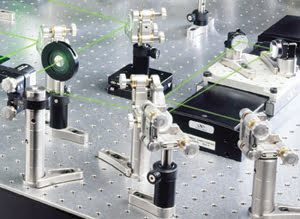James Fisher and Warren Booth, Newport Corp.
Research into ultrafast phenomena continues to be a dominant area of investigation, with wide-ranging applications in biological imaging, remote sensing, materials analysis and machining. Scientists continue to look for techniques to improve system performance and for additional applications. As the laser illumination sources for these systems move from picosecond- to femtosecond-pulse devices and beyond, a higher level of automation and control will be required to provide the required repeatability, stability and accuracy.
In most cases, the challenge will be to create motion and change without inducing unwanted vibration and movement. Although motion control was used in early ultrafast applications, future ones will require a higher level of precision and stability, particularly in high-resolution imaging.
For today’s experimental applications and for future applications, such as imaging, medical procedures, DNA sequencing and spectroscopy, the ability to precisely control and record beam-line components and target sample positions is vital. Motion is of two sorts: that directed by the user and implemented by some type of motorized device, and that from the environment, such as floor or machinery vibration and acoustic or thermal effects. Motion and vibration control for ultrafast applications are related, and eliminating potential interference from vibration while improving motion sensitivity improves the integrity of gathered data and the performance of the system.
Outside of the laser, motion control, when applied to early ultrafast studies, typically was concerned with mirror-mount adjustment and delay lines. Motorized mirror mounts were used to change or correct beam alignment, but because of their expense, they were used only on the most critical or hard-to-reach mounts, where remote control made adjustments easier or safer (such as in high-power studies). On delay lines, researchers historically have used leadscrew-driven stages to change the delay distance. This allowed for both small and large distance changes, but in general, the changes were very slow, on the order of 100 mm/s at most.
However, as technology has advanced, so have the tools that are available. Many improvements have been made in the area of automation and precision control that have driven down costs while boosting product performance.
Today, mirror mounts can be equipped with low-cost, highly sensitive motorized actuators that can be computer-controlled, becoming part of a closed-loop, active-alignment system. The controller may feature both manual and computer control, which is invaluable when developing an automated alignment process or when a small, one-time adjustment is needed.
Delay lines also are seeing the benefit of improved technology and manufacturing. Although similar to early versions, they now incorporate high-speed “rapid scanning” devices, including voice coils, linear motors or galvanometers, providing millimeter-scale movement at kilohertz rates for changing path length, focus depth and point of interference in the most advanced ultrafast applications.
The miniaturization of components also eases the adoption of the technology for new applications and may be the key to its commercial success. Miniature motorized positioners and mounts are becoming increasingly specialized, providing more than simple mirror alignment or direction.
The ability to manipulate components on the submicron scale requires not only very sensitive positioners, but also very good isolation from external disturbances. Historically, this has been accomplished with high-quality optical tables supported by pneumatic isolators. Recent advances in active-isolation technology have spawned many product solutions. Some offer good isolation but only for a narrow band of applications, while others are more flexible but provide only nominal performance improvement over traditional methods.

Precise control of the delay line and tuned vibration damping enables researchers to perform state-of-the-art experiments in a challenging operating environment.
One of the most encouraging advancements in the area of vibration control for research comes from facility design. New research centers are being designed to minimize noise transmission through floor and wall structures that can cause significant disturbances in sensitive experiments. With improved lab environments, vibration concerns shift toward vibration damping, or the dissipation of energy in the table structure, and away from vibration isolation, or the reduction of the transmission of vibration from the floor to the table.
There are two main types of vibration damping: broadband and tuned. Broadband provides a moderate level of damping across a range of frequencies, but does not target the more dominant vibration frequencies, inherent in any structure. Tuned, considered by many experts as the most efficient and effective, targets specific natural frequencies in a structure and provides much higher damping than broadband. For more demanding applications, however, many researchers are turning to custom-tuned tables that account for the application’s load condition.
Even in the most controlled environment, there are many potential sources of vibration, including acoustic from machinery, lasers, instruments, lighting, HEPA filters and water lines. Disturbances come from air-handling ducts, fans, doorways and building sway, as well as from system components such as optical mounts, posts or other vertical components that can act like antennae for ambient vibrations. With all these localized disturbances, effectively damping a table surface is a must.
Researchers are increasingly turning to a number of solutions. To reach the highest level of precision and sensitivity, they are incorporating both active and passive isolators and optical components with internal damping into their setups.
As ultrafast phenomena continue to be applied to more applications, suppliers will develop more sophisticated products. And as the number of applications grows, scientists should expect to see more advances in the near future.
Meet the authors
James Fisher is a director of product marketing and Warren Booth is a product manager at Newport Corp. in Irvine, Calif.; e-mail: [email protected] or [email protected].